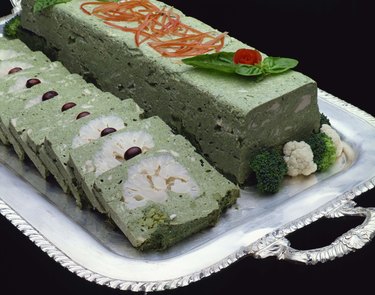
Sterling silver serving dishes bring a matchless luster to a dinner table. While some hosts hesitate to use sterling serving pieces because they are concerned about food interactions and tarnish, others will assure you that frequent usage is the best way to keep your serving dishes shiny. Sterling silver is perfect for serving some foods and less suitable for others. A bit of knowledge about food chemistry will help you use your sterling at its beautiful best.
About Tarnish
Video of the Day
The black streaks and film that tarnish silver are composed of silver sulfide and can result from the silver's reaction with sulfur compounds. These are found naturally in wood, felt, rubber, newspaper and some plastics, and in the air in the form of hydrogen sulfide, a component of air pollution. Eggs, onions and vegetables in the Brassicaea family, such as broccoli and cabbage, contain a high level of sulfur compounds. Acidic foods such as vinegar or fruit juice intensify the formation of tarnish sulfides. Even the lemon-scented agents in cleaning products can add to the problem. Tarnish can also be formed by exposure to chlorine, as in bleach; tobacco smoke; fossil fuels; or the acids on human skin, a common problem with sterling silver jewelry.
Video of the Day
Other Concerns
Some people worry that interactions between food and silver serving pieces can produce compounds toxic to humans. Much of this concern stems from the discovery of high lead content in silver-plated tableware in the 1970s and 1980s. Silver plating involves putting a layer of silver over base metal alloys that can include copper as well as lead. Surface scratching, thin plating and abrasive polishing can wear away silver to the point that acid foods can leach out and absorb toxic alloy components. Sterling silver, on the other hand, is 92.5 percent silver throughout, combined with a copper-based alloy to increase hardness. High silver content means that acidic foods may stain sterling, but the staining does not transfer to food.
Foods to Serve
Non-acidic foods such as meat, potatoes, noodles, rice and most vegetables are ideal for serving in sterling. Dishes with dairy-based sauces, such as scalloped potatoes, can be served in sterling, although you may wish to add a glass liner to avoid the hard scrubbing it may take to remove a thick sticky sauce from your silver. Use sterling for coffee and tea service, baked goods and whole fresh fruit. For a festive brunch, for example, put eggs in a glass casserole but set out your silver for the bacon and waffles.
Foods to Avoid
Acids like vinegar and lemon, tomato or other fruit juices will stain your serving pieces and are best served in other containers. If your beef roast has been basted with a vinegar-based sauce or you want to dress asparagus with a bit of lemon juice, you may need to check your silver for streaks of tarnish after you have washed it. The higher the acid and sulfide content of food, the more likely immediate polishing will be required. Onions, eggs, garlic, spinach and cabbage are all high-sulfide foods. When acid and sulfides combine, as in mayonnaise, salsa or sauerkraut, tarnishing is inevitable. Another possibly surprising source of tarnish is salt. Lightly salted foods present no problem, but salt left in sterling-silver salt shakers can both tarnish and pit metal. Empty and rinse shakers after each meal to prevent salt damage.
- Lifetime Sterling: Caring for Sterling Silver
- Silver Gallery: History of Sterling Silver
- MetalBrite Products: How Silver Tarnishes
- Mrs. Clean: Caring for Silver
- Canadian Institut de Conservation: How to Care for Silver
- United States Food and Drug Administration: CPG Section 545.500 Silver Plated Hollowware - Lead Contamination